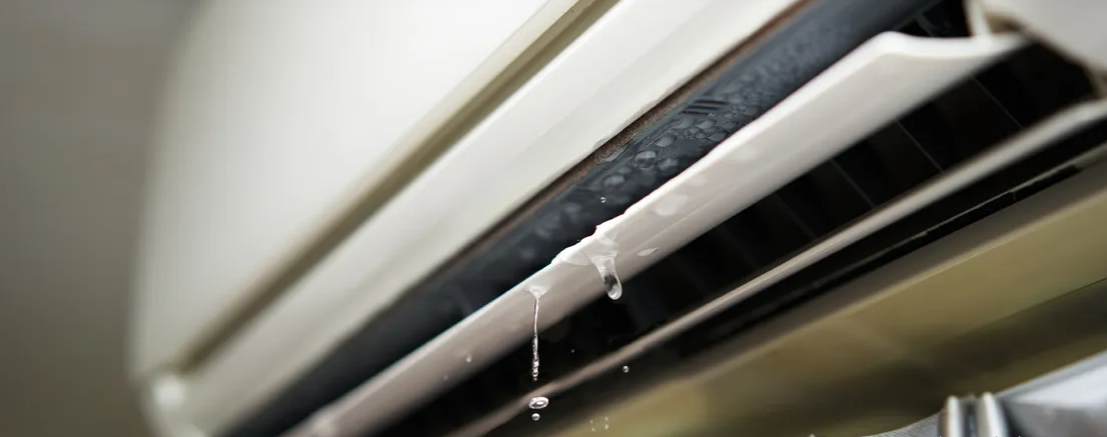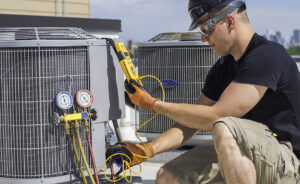A surprising set of materials could soon help make more efficient air conditioners that don’t overtax the electrical grid on hot days.
As extreme heat continues to shatter records around the globe, electricity demand for air conditioning is expected to triple in the next few decades—an increase of about 4,000 terawatt-hours between 2016 and 2050, according to the International Energy Agency, or roughly the same electricity demand as the entire US electrical grid in 2022.
That’s why the race to build more efficient air conditioners has become increasingly urgent. While some companies are focused on improving existing designs, others are looking to entirely new systems that use materials called desiccants. These systems could cool more efficiently, even in extreme heat and humidity, reducing stress on the grid.
A typical air conditioner cools indoor spaces by pumping a refrigerant around in a cycle and through heat exchangers, soaking up heat from the inside air and releasing it outside. (Heat pumps work in the same way, either running the opposite direction, or in reversible systems that can both heat and cool.)
That approach, called vapor compression, is over 100 years old, and the basic design hasn’t changed much since its invention, says Ankit Kalanki, a manager in the carbon-free buildings program at the Rocky Mountain Institute, a nonprofit energy think tank. Pumping refrigerant around and compressing it enough to shuttle heat outside requires a lot of energy, especially when temperatures are very high.
apor compression systems also deal with humidity and heat together, which is another drawback. Keeping a building comfortable has a lot to do with maintaining a low humidity environment, Kalanki says, but air conditioners must cool down air to pull moisture out of it. Without a designated system to tackle humidity, he says, buildings are often “over-cooled,” which can add a huge energy burden.
Systems that tackle dehumidification and cooling separately could keep building temperatures comfortable with less energy and allow for more flexibility in different environments. And a growing number of startups are looking to desiccants to accomplish just that.
Hot take
Desiccants are materials that suck up moisture. The silica beads in those little packets that accompany new purses and shoes are a type of desiccant, designed to keep products dry as they’re shipped around the world.
Other types of desiccants could be added to existing designs for air conditioners, absorbing water from the air and cutting down on the energy required to keep rooms comfortable. Transaera, an MIT spinout founded in 2018, is developing a hybrid system that uses a type of material called metal organic frameworks. Adding the materials to vapor compression-based air conditioners could allow the company’s system to use 35% less energy than average models, according to Transaera CEO Sorin Grama.
But other companies are looking to use desiccants in cooling systems that would replace traditional air conditioners altogether. Florida-based startup Blue Frontier, for example, is using liquid desiccants to build cooling systems. The key ingredient is different from the silica beads in shoe packaging, but the comparison is a common one—“We get that a lot,” says Matt Tilghman, the company’s co-founder and chief technology officer.
Rather than small silica beads, Blue Frontier’s cooling technology relies on a salt solution that’s so concentrated, it can pull moisture from the air.
Here’s how Blue Frontier’s cooling system works: first, a stream of air passes through a channel and over a thin layer of desiccant, which pulls moisture out of the air. Next, the now-dry air goes through an evaporative cooling step, which lowers the temperature of the air (basically the same way sweat cools your skin).
In the evaporative cooling step, the air is split into two streams. One runs past a thin layer of water, which absorbs energy and drops the air’s temperature. That cooler, humid air is used to cool a metal surface, which in turn sucks heat out of the other stream of still-dry air. The humid air gets funneled outside, and the cool, dry air is blown into the building.
Evaporation is an efficient cooling method, one that’s employed in low-cost devices called air coolers (also referred to as swamp coolers or evaporative coolers), which can use 80% less electricity than standard air conditioners. These devices usually add moisture to the air to cool it, which only works when starting with dry air, so their use is typically limited to dry environments, like the southwestern US.
By pairing evaporative cooling with desiccants, Blue Frontier’s system can work in virtually any climate, Tilghman says. Its operations can be tweaked to handle changes in the weather or in the thermostat set point, altering the balance between cooling and dehumidifying, which could help unlock further efficiency gains. The company’s approach should be able to cut annual electricity use by a total of between 50% and 80% compared with a conventional air conditioning system, depending on the environment, Tilghman says.
On thin ice
Liquid desiccants are sometimes used today to dehumidify warehouses or factories that need to keep strict controls on moisture in the air, such as in pharmaceutical or electronics manufacturing. But they haven’t been widely used in cooling partly because they’re expensive. One industry standard, lithium chloride, has been subject to price hikes and supply limitations because of demand for it in lithium-ion batteries. The materials can also be corrosive. (Blue Frontier is using a new desiccant that should address those concerns, Tilghman says.)
One of the biggest roadblocks to widespread desiccant cooling has been the need for a method to recharge the materials efficiently. Desiccants are like sponges—they can suck up a limited amount of water before they need to be wrung out, or regenerated.
So in addition to the parts that dry and cool air, a desiccant cooling system needs a section that can regenerate the desiccant, releasing the water into another stream of air that in turn is released outside.
Most desiccants can be regenerated through heating, which releases water from the material, but that step can be energy-intensive and often involves fossil fuel-powered boiler systems.
Blue Frontier instead uses a heat pump to regenerate its desiccant. The heat pump adds energy demand, but while the cooling system can run continuously during a hot summer day, the regeneration system can run in the evening or overnight, when there’s less stress on the grid and electricity prices are lower, Tilghman says. Offsetting the regeneration will mean that Blue Frontier’s system could help reduce peak power demand by between 80% and 90%.
Other startups are looking to get rid of the need for heat altogether. Boston-based Zephyr is hoping to use membranes to filter water out of liquid desiccants to regenerate them, similar to the process used to pull salt out of water in desalination facilities.
Zephyr demonstrated parts of its system in July and plans to assemble a full lab-scale prototype of a cooling system later this year. Its desiccant cooling device could use about 45% less electricity than the best vapor-compression air conditioners on the market today, says Jacob Miller, Zephyr’s co-founder and chief technology officer.
Blue Frontier has two demonstration cooling systems running, one in Florida and one in Canada, and the company has plans to install several dozen more in late 2023 and 2024, Tilghman says.
Both startups are focusing first on systems for larger commercial buildings, but down the line the systems could be adapted for houses and even individual apartments, Tilghman says. Blue Frontier’s first systems will be more expensive than existing air conditioners at the outset, he adds, though they should be able to make up for it in energy savings within three to five years.
Access to efficient cooling technology could be crucial to helping more people live and work in safe environments without overloading grids. “If you look at the warming world, the way temperatures are rising, you need people to have access to cooling,” Kalanki says. “It’s not just an issue of thermal comfort or feeling productive, it’s also an issue of equity now.”
Text taken from: https://www.technologyreview.com






